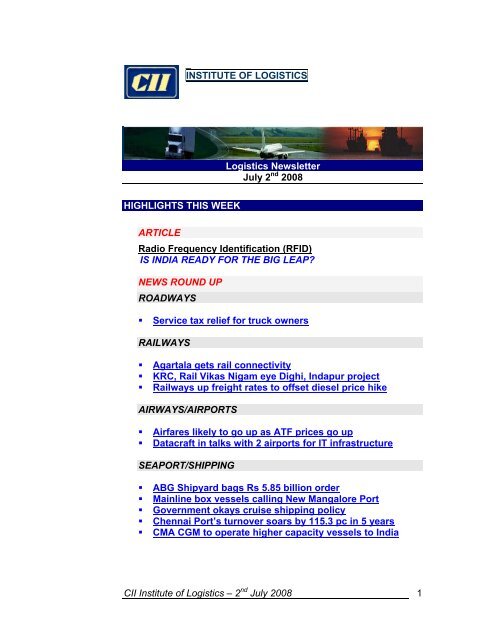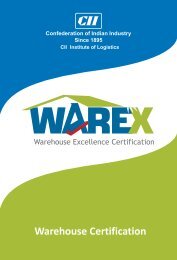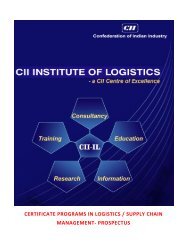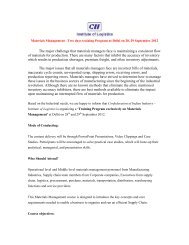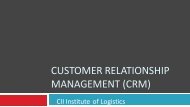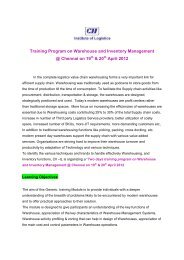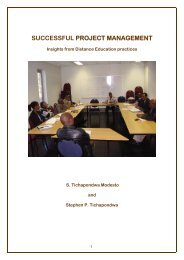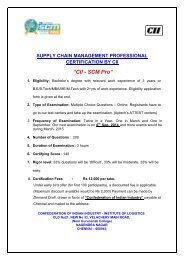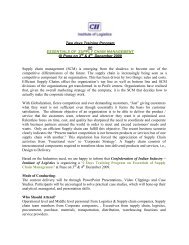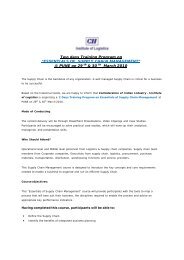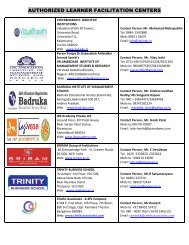CIIL Weekly Logistics Newsletter CII Institute of Logistics â 2nd July ...
CIIL Weekly Logistics Newsletter CII Institute of Logistics â 2nd July ...
CIIL Weekly Logistics Newsletter CII Institute of Logistics â 2nd July ...
You also want an ePaper? Increase the reach of your titles
YUMPU automatically turns print PDFs into web optimized ePapers that Google loves.
<strong><strong>CII</strong>L</strong> <strong>Weekly</strong> <strong>Logistics</strong> <strong>Newsletter</strong><br />
_<br />
INSTITUTE OF LOGISTICS<br />
<strong>Logistics</strong> <strong>Newsletter</strong><br />
<strong>July</strong> 2 nd 2008<br />
HIGHLIGHTS THIS WEEK<br />
ARTICLE<br />
Radio Frequency Identification (RFID)<br />
IS INDIA READY FOR THE BIG LEAP<br />
NEWS ROUND UP<br />
ROADWAYS<br />
• Service tax relief for truck owners<br />
RAILWAYS<br />
• Agartala gets rail connectivity<br />
• KRC, Rail Vikas Nigam eye Dighi, Indapur project<br />
• Railways up freight rates to <strong>of</strong>fset diesel price hike<br />
AIRWAYS/AIRPORTS<br />
• Airfares likely to go up as ATF prices go up<br />
• Datacraft in talks with 2 airports for IT infrastructure<br />
SEAPORT/SHIPPING<br />
• ABG Shipyard bags Rs 5.85 billion order<br />
• Mainline box vessels calling New Mangalore Port<br />
• Government okays cruise shipping policy<br />
• Chennai Port’s turnover soars by 115.3 pc in 5 years<br />
• CMA CGM to operate higher capacity vessels to India<br />
<strong>CII</strong> <strong>Institute</strong> <strong>of</strong> <strong>Logistics</strong> – 2 nd <strong>July</strong> 2008 1
<strong><strong>CII</strong>L</strong> <strong>Weekly</strong> <strong>Logistics</strong> <strong>Newsletter</strong><br />
WAREHOUSING/DISTRIBUTION<br />
• Ramco wins <strong>Logistics</strong> order from Continental Carriers<br />
INTERNATIONAL NEWS<br />
• India placed 71st in trade index<br />
• TNT Express launches time-sensitive heavy shipments<br />
• Four airlines fined for cargo price-fixing<br />
• HK may award CT10 contract to lines<br />
• Trans-Balkan oil pipeline cost rises to 1.5 bln euros<br />
• FEFC carriers see 11.4% westbound growth in May<br />
• Tianjin Port handles 26million tonne <strong>of</strong> iron ore in 5<br />
months<br />
• Rising China demand for diesel fuels spot freight rates<br />
• Swift Global <strong>Logistics</strong> signs MOA with Topocean Group-<br />
Singapore<br />
INDICATIVE FREIGHT RATES<br />
• Indicative Ocean Freights to various Sea Ports<br />
• Indicative Trucking Rates in India<br />
• Air Freight Rates (domestic & international)<br />
<strong>CII</strong> <strong>Institute</strong> <strong>of</strong> <strong>Logistics</strong> – 2 nd <strong>July</strong> 2008 2
<strong><strong>CII</strong>L</strong> <strong>Weekly</strong> <strong>Logistics</strong> & Freight <strong>Newsletter</strong><br />
ARTICLE<br />
Radio Frequency Identity (Rfid)<br />
IS INDIA READY FOR THE BIG LEAP<br />
Radio Frequency Identification Technology, known widely by its ubiquitous<br />
abbreviation RFID, with its cutting edge business applications and benefits<br />
has inspired an endless array <strong>of</strong> possibilities and applications. The<br />
technology indeed, existed for decades before but it was on June 10, 2003<br />
that Linda Dillman, the Chief Information Officer (CIO) <strong>of</strong> Wal-Mart set the<br />
ball rolling with an announcement that their top 100 suppliers would be<br />
henceforth required to utilize Radio Frequency Identification (RFID) tags<br />
on their cases and pallets by January 2005.<br />
This announcement truly set the RFID technology into motion as various<br />
stakeholders in the Wal-Mart supply chain world-wide, including other<br />
major retailers and logistics and supply chain partners started evaluating<br />
various strategies and practices to cope with the possibilities and meeting<br />
challenges <strong>of</strong> this new technological mandate. The RFID technology<br />
needed a big push and Wal-Mart initiative gave it a necessary momentum<br />
and brought it to centre-stage <strong>of</strong> market.<br />
The hype and hoopla <strong>of</strong> RFID promise still stares the potential user<br />
industry in its face. The hope, disappointment and promise that this<br />
technology has evoked has now turned one full circle. IT research firm<br />
Gartner in its recent report - Market Share and Forecast: Radio Frequency<br />
Identification, Worldwide, 2004-2010 – has estimated that world-wide<br />
RFID market will grow from $504 million this year to $3 billion in 2010.It<br />
was earlier reckoned to touch this level by end-2008. The RFID industry,<br />
says Gartner report is starting to come out <strong>of</strong> the trough <strong>of</strong> disillusionment,<br />
referring to a phase in its famed "Hype Cycle" model that tracks the<br />
adoption <strong>of</strong> emerging technologies. It means that after the RFID hype<br />
over-heated earlier, the industry had slumped as optimism turned to<br />
skepticism about the technology and its benefits. Now the tide, it says is<br />
starting to turn in its favour. On a cautionary note the report notes that<br />
there is still need for demonstration <strong>of</strong> meaningful results about values<br />
gained from its existing deployments.<br />
The promise <strong>of</strong> this technology notwithstanding, it has from its very<br />
inception thrown up an avalanche <strong>of</strong> questions – what is this RFID<br />
technology really all about; how is it going to be implemented across<br />
industries and markets; how would it really suit the requirement <strong>of</strong><br />
different stakeholders in a business value chain; what tangible and<br />
intangible benefits would accrue from adopting this technology and more<br />
importantly, who would bear the cost <strong>of</strong> implementing/adopting this<br />
technology.<br />
<strong>CII</strong> <strong>Institute</strong> <strong>of</strong> <strong>Logistics</strong> – 2 nd <strong>July</strong> 2008 3
<strong><strong>CII</strong>L</strong> <strong>Weekly</strong> <strong>Logistics</strong> & Freight <strong>Newsletter</strong><br />
Arguably, there is no ready “fit-one-fit-all” kind <strong>of</strong> convincing answers to<br />
any <strong>of</strong> the basic questions. Yet, as the number <strong>of</strong> RFID users world-wide,<br />
including in India, keep multiplying, wide range <strong>of</strong> RFID-related<br />
implementation practices are coming into broader view and this should<br />
certainly help in finding the answers to some <strong>of</strong> the questions indicated.<br />
What is RFID<br />
Radio Frequency Identification (RFID) is an e-tagging technology that<br />
provides businesses an opportunity to add electronic identities to any<br />
product, inventory or asset. These RFID tags store data, which can be<br />
remotely accessed. This allows integration with the information technology<br />
system and easy operations. Companies, which seek highest standards in<br />
supply chain management, logistics and transportation security, have<br />
started using the technology to ensure maximum RoI (Return on<br />
Investment).<br />
Successful adoption <strong>of</strong> this technology, however, largely depends on its<br />
integration with the existing business applications and enterprise<br />
solutions. Among likely user industries, large retail outlets, manufacturing<br />
industries, warehouses, travel/car fleet units and airports are some<br />
significant adopters <strong>of</strong> this technology for managing security, access<br />
control, logistics as well as real time information access and updates. The<br />
RFID technology is also finding its place in access control systems <strong>of</strong><br />
vehicle parking lots and toll roads, expressways and bridges. It can also<br />
find its use in high density and high value client-specific transactions <strong>of</strong><br />
banks, judiciary and government to track important document files.<br />
In the logistics industry, the RFID can deliver many advantages, including<br />
traceability <strong>of</strong> assets within the supply chain, optimum order management<br />
and improved product availability. In the future, the RFID logistic solutions<br />
would use the RFID technology throughout the complete supply chain to<br />
achieve seamless integration <strong>of</strong> operations. Logistic RFID systems can be<br />
used for numerous applications in production, inventory warehousing<br />
logistics and distribution. - RFID tagged containers, boxes and carriers,<br />
work piece carriers and tools in assembly lines, airports and automobile<br />
production, and for access control to company property and parking<br />
facilities.<br />
Products can also be tracked whilst in the possession <strong>of</strong> consumers and<br />
habits and trends identified. A benefit <strong>of</strong> RFID in logistics is that it can also<br />
reduce costs and wastage within the supply chain. Costs are lowered as<br />
the increased visibility <strong>of</strong> products through the supply chain helps reduce<br />
shrinkage and errors. Savings can be achieved from the removal <strong>of</strong><br />
<strong>CII</strong> <strong>Institute</strong> <strong>of</strong> <strong>Logistics</strong> – 2 nd <strong>July</strong> 2008 4
<strong><strong>CII</strong>L</strong> <strong>Weekly</strong> <strong>Logistics</strong> & Freight <strong>Newsletter</strong><br />
manual processes due to automated scanning <strong>of</strong> assets, rather than the<br />
manual scanning <strong>of</strong> bar codes.<br />
How does it work<br />
The main component <strong>of</strong> RFID technology is the transponder/tag1, which in<br />
most cases comprises <strong>of</strong> a chip and antenna mounted onto a substrate or<br />
an enclosure. The chip consists <strong>of</strong> a processor, memory and radio<br />
transmitter. These transponders communicate via radio frequency to a<br />
reader, which has its own antennas. The readers can interface through<br />
wired or wireless medium to a main computer. Transponders are also<br />
known as smart or radio tags. The memory will vary, depending on the<br />
manufacturer, from just a few characters to kilobytes.<br />
Transponders can either be Read Only (R/O) which are pre-programmed<br />
with a unique identification or they can be Read Write (R/W) for<br />
applications that require data to be stored in the transponder and can be<br />
updated dynamically. Another form <strong>of</strong> transponder is Write Once Read<br />
Many times (WORM). This will allow for an identification number to be<br />
written to the transponder once. The information is stored in the memory,<br />
it cannot be changed but the transponder can be read many times.<br />
The two most common types <strong>of</strong> RFID technologies are Active and<br />
Passive. Active RFID transponders are self-powered and tend to be more<br />
expensive than Passive one. Having power on board allows the active tag<br />
to have greater communication distance and usually larger memory<br />
capacity.<br />
As for Passive RFID transponders, which are available with chips and<br />
without chips, they have no internal power source therefore, require<br />
external power to operate. The transponder is powered by an<br />
electromagnetic signal that is transmitted from a reader. The signal<br />
received will charge an internal capacitor on the transponder, which in turn<br />
will then supply the power required to communicate with the reader.<br />
RFID logistic Electronic tags contain memory and readers extract the data<br />
stored on the tag. If you attach the tag to a product, and store on it an<br />
Electronic Product Code (EPC), which is a unique product identifier For<br />
example, a can <strong>of</strong> soup would have a tag on it that contained information<br />
such as who manufactured it and its unique number and transport and<br />
disposal history. A RFID tag on a container <strong>of</strong> multiple products such as a<br />
pallet, the asset can then be tracked giving visibility and reduced<br />
shrinkage / loss.<br />
<strong>CII</strong> <strong>Institute</strong> <strong>of</strong> <strong>Logistics</strong> – 2 nd <strong>July</strong> 2008 5
<strong><strong>CII</strong>L</strong> <strong>Weekly</strong> <strong>Logistics</strong> & Freight <strong>Newsletter</strong><br />
BENEFITS OF RFID IN LOGISTICS & SCM<br />
Benefit<br />
Increased<br />
Accuracy<br />
Faster<br />
Throughput<br />
Lower<br />
Inventory<br />
Description<br />
Sensors can automatically detected missing or misdirected<br />
shipments and raise an alert. Because scanning<br />
requires no human intervention, it can be done more<br />
<strong>of</strong>ten, thus increasing the granularity <strong>of</strong> supply chain<br />
visibility.<br />
Thanks to RFID’s ability to scan multiple tags<br />
simultaneously—up to 400 per second with most<br />
advanced UHF systems—the case-level contents <strong>of</strong><br />
entire pallets can be scanned at key locations like<br />
warehouse dock doors, all without human intervention.<br />
Increased accuracy and visibility allows manufacturers,<br />
distributors, and retailers to maintain lower inventory<br />
levels, thus freeing capital. An RFID-enabled supplychain<br />
essentially allows for lower inertia, making the<br />
whole system more responsive.<br />
RFID Users in India<br />
RFID usage in India is still limited to few users and industries, though by<br />
no means this is to be construed as any indication either its relevance or<br />
potential benefits. The promise <strong>of</strong> RFID technology are indeed, many and<br />
are similarly placed as computers, which were seen ,only some two<br />
<strong>CII</strong> <strong>Institute</strong> <strong>of</strong> <strong>Logistics</strong> – 2 nd <strong>July</strong> 2008 6
<strong><strong>CII</strong>L</strong> <strong>Weekly</strong> <strong>Logistics</strong> & Freight <strong>Newsletter</strong><br />
decades back, as though it were some distant dream. By all reckoning, the<br />
adoption <strong>of</strong> RFID technology may indeed, prove to be far quicker than<br />
could ever be anticipated in the past.<br />
A significant entry barrier that is holding back this technology from<br />
becoming widespread in India is the relatively high unit cost <strong>of</strong> RFID chips<br />
but with the cost <strong>of</strong> manufacturing these chips going down exponentially, it<br />
is now becoming more acceptable.<br />
Reliance Retail, one <strong>of</strong> India's largest retailers, has been testing RFID<br />
technology and is preparing applications for use at a large number <strong>of</strong> its<br />
hypermarkets and supermarkets, as well as its electronics and<br />
convenience stores. The company has already equipped these stores with<br />
data ports and wireless computer networks able to support RFID systems.<br />
Reliance Retail has drawn up plans for using RFID to support its<br />
operations. The company has developed five RFID-deployment scenarios,<br />
including the tracking <strong>of</strong> reusable crates <strong>of</strong> fresh food; item- and case-level<br />
tracking <strong>of</strong> high-value goods; and pallet and case tagging <strong>of</strong> various<br />
goods.<br />
Reliance has performed pro<strong>of</strong>-<strong>of</strong>-concept tests using passive EPC Gen 2<br />
UHF RFID tags to track crates <strong>of</strong> fresh foods and cases <strong>of</strong> high-value<br />
goods. The company managed to achieve above 90 percent read rates<br />
and found that RFID helped it reduce shipping and receiving errors while<br />
increasing productivity. For the test to track individual items and cases <strong>of</strong><br />
high-value goods, Reliance Retail has recently conducted a pilot between<br />
one distribution center and one Reliance Digital store. This pilot is still<br />
under evaluation. Reliance is now working with various RFID hardware<br />
and tag suppliers to obtain improved read rates for the tracking <strong>of</strong> freshfood<br />
crates, as well as planning a permanent rollout <strong>of</strong> other scenarios<br />
upon successful completion <strong>of</strong> the pilots.<br />
Case Study<br />
SCORE deploys RFID in Textile Industry<br />
First major deployment <strong>of</strong> Contactless Smart Cards and RF ID for quality<br />
assurance and production flow automation in the textile industry has been<br />
successfully completed by Score Information Technologies Limited at<br />
AMFL, Kolkata.<br />
Through this integrated solution various problems <strong>of</strong> Textile Industry, in<br />
particular Quality Assurance, Work Flow Automation, stocks, Machine<br />
maintenance, have been successfully addressed. Problems <strong>of</strong> false<br />
reporting, employee favours have been adequately addressed while<br />
substantial improvement in efficiency and improved production quality<br />
<strong>CII</strong> <strong>Institute</strong> <strong>of</strong> <strong>Logistics</strong> – 2 nd <strong>July</strong> 2008 7
<strong><strong>CII</strong>L</strong> <strong>Weekly</strong> <strong>Logistics</strong> & Freight <strong>Newsletter</strong><br />
have motivated the customer to invest further and deploy the solution for<br />
other production sites as well. Total <strong>of</strong> 1,700 looms employing about 9,000<br />
people have now started using RFID solution for their work flow<br />
automation. Integration with EFFECT, an ERP solution from Score, has<br />
made it a complete solution. The environment was Oracle 8i, Visual Basic<br />
on Windows XP.<br />
Infenion's RF ID chips popularly known as 'my-d' were used for the<br />
purpose. The RFID inlays have Intelligent 10 kbit EEPROM with<br />
contactless interface complying to ISO/IEC 15693 and security logic. my-d<br />
supports the "Chip Sharing Approach" (CSA). Secure memory sectors on<br />
my-d ICs enable different stakeholders in a (secure) supply chain to<br />
handle data. Defined access rules enable the authorized users to work<br />
with the relevant data. Score has adopted a smart way to exploit the<br />
economic potential <strong>of</strong> RFID technology.<br />
Rajasthan State Road Transport Corporation (RSTC) is another user <strong>of</strong><br />
RFID with its passenger buses moving between Delhi and Jaipur fitted<br />
with RFID transponders, enabling their movement to be tracked. RFID is<br />
can be used together with VSAT to track road vehicles. A registered user<br />
can log on to the system through the Internet and can view the current<br />
status <strong>of</strong> the vehicle. Many companies in developed countries take<br />
advantage <strong>of</strong> this tracking technology in their fleet operations. An<br />
estimated daily 2.5-3 million trucks move cross the country, logging about<br />
300 km a day, against 800 km in developed countries. A 10 per cent<br />
increase data in real time. This data is transmitted to the Internet, and then<br />
to the company's computers, for viewing the productivity <strong>of</strong> trucks would<br />
yield an annual saving <strong>of</strong> some Rs 20,000 crore. Truck transporters use<br />
mobile phones that have GPS tracking. Identification via RFID tags also<br />
helps reduce warehousing costs and error rates in the supply chain.<br />
The Centre for Railway Information Systems (CRIS) <strong>of</strong> Indian Railways<br />
similarly too uses Radio Frequency Identification (RFID) technology to<br />
improve the wagon management system <strong>of</strong> the Railways. CRIS proposes<br />
to have a RFID tag or chip embedded in all the wagons and provides<br />
sheds with handheld devices that would read these chips and thus register<br />
the data. Following this, the details can be fed into the Indian Railways<br />
system to help track wagons accurately. A pilot project will be run in the<br />
East Coast Railways.<br />
<strong>CII</strong> <strong>Institute</strong> <strong>of</strong> <strong>Logistics</strong> – 2 nd <strong>July</strong> 2008 8
<strong><strong>CII</strong>L</strong> <strong>Weekly</strong> <strong>Logistics</strong> & Freight <strong>Newsletter</strong><br />
WEEKLY NEWS ROUND UP<br />
ROADWAYS<br />
Service tax relief for truck owners<br />
Supply <strong>of</strong> transport vehicles to goods transport agency (GTA) for transport<br />
<strong>of</strong> goods by road will not attract service tax, the Finance Ministry has<br />
stated. Budget 2008-09 had said that services provided in relation to<br />
supply <strong>of</strong> tangible goods for use, without transfer <strong>of</strong> possession and<br />
effective control would attract service tax from May 16. The field<br />
formations in the revenue department had taken a stance that goods<br />
carriage (transport vehicles) would be covered under this provision and<br />
hence service tax would be applicable on supply <strong>of</strong> goods carriage to<br />
GTA. Based on the representation <strong>of</strong> the All India Confederation <strong>of</strong> Goods<br />
Vehicles Owners Association (ACGVOA) and also from the All India Motor<br />
Transport Congress, the Finance Ministry has exempted fully the levy <strong>of</strong><br />
service tax on supply <strong>of</strong> goods carriage to GTA for use in transportation <strong>of</strong><br />
goods by road.<br />
AIRLINES/AIRPORTS<br />
Airfares likely to go up as ATF prices go up<br />
Airfares are likely to go up further with the state owned oil firms deciding to<br />
increase aviation turbine fuel (ATF) prices by another Rs2,500-3,000 per<br />
kilolitre with effect from <strong>July</strong> 1. Any increase in ATF prices is set to be<br />
passed on to consumers as airlines have refused to absorb any further<br />
losses. Oil price has gone up from $121 per barrel, when ATF prices were<br />
last revised on June 5 to an all-time high <strong>of</strong> $142 per barrel now, reflecting<br />
a 15% increase in less than a month. Consequently, oil companies are left<br />
with no option but to increase the ATF prices. It would be in the range <strong>of</strong><br />
Rs 2,500 per kilo litre to Rs 3,000 per kilo litre. The price hike will be<br />
announced on Monday and be effective from Tuesday, said the executive<br />
director <strong>of</strong> a leading oil PSU. The airlines will evaluate the impact <strong>of</strong> ATF<br />
price hike after it is announced on Monday. ATF prices account for over<br />
45% <strong>of</strong> the operational cost <strong>of</strong> airlines. ATF is sold in a range <strong>of</strong> Rs 66,226<br />
to Rs 73,473 per kilo litres in different cities, over 80% higher than the<br />
prices globally. According to Capa estimates, India’s airlines are likely to<br />
lose a combined $1.5 billion this fiscal, more than double a year earlier,<br />
because <strong>of</strong> the surge in jet fuel prices.<br />
Datacraft in talks with 2 airports for IT infrastructure<br />
Datacraft Asia, a $580-million Singapore-based provider <strong>of</strong> IT<br />
infrastructure and related solutions, is in talks with the New Delhi and<br />
Bangalore airport authorities to set up IP telephony-based infrastructure.<br />
<strong>CII</strong> <strong>Institute</strong> <strong>of</strong> <strong>Logistics</strong> – 2 nd <strong>July</strong> 2008 9
<strong><strong>CII</strong>L</strong> <strong>Weekly</strong> <strong>Logistics</strong> & Freight <strong>Newsletter</strong><br />
The company recently completed work as a consultant with one <strong>of</strong> the<br />
airports and helped design its security and overall design layout. Datacraft<br />
has put in place IP telephony-based IT infrastructure for the Hong Kong<br />
and Bangkok airports with the basic infrastructure cost alone amounting to<br />
about $10 million (about Rs 40 crore).. With the entry <strong>of</strong> private players in<br />
the airports space, the Government is striving for the best infrastructure.<br />
Internet Protocol (IP) telephony enables voice communication over the<br />
Internet. Here, voice and data exist on one network and can be centrally<br />
maintained. Instead <strong>of</strong> separate, multi-line phones, beside a PC at each<br />
desk, IP telephony allows s<strong>of</strong>tware on the PC to serve as a s<strong>of</strong>t phone.<br />
Unlike telephone hardware, this can be easily upgraded and enhanced,<br />
without work disruption, extra equipment cost or even visiting each desk<br />
for manual installation. All end points in a particular place can be made IPenabled<br />
and connected on to one system. For an airport, these include<br />
security cameras and their network, flight details and announcements,<br />
baggage check-in, free WiFi ports and telephone services for passengers<br />
and ground service functions <strong>of</strong> airlines. The company plans to add about<br />
250 employees this year to its existing 800 in India and 5-6 local business<br />
partners. Current partners in India include Cicso and Micros<strong>of</strong>t. It expects<br />
to total revenues to cross $650 million thereby registering a compounded<br />
annual growth rate <strong>of</strong> over 20 per cent.<br />
RAILWAYS<br />
Agartala gets rail connectivity<br />
It's a dream come true for the people <strong>of</strong> Tripura, with the entry <strong>of</strong> the first<br />
railway engine <strong>of</strong> the Northeast Frontier Railways to Agartala station<br />
during a trial run for the 67 km long Agartala-Ambash rail line on 29 th<br />
June. By the end <strong>of</strong> September this year, after the clearance <strong>of</strong> railway<br />
security board, passenger and goods trains are expected to run. People<br />
have high hopes with the train as they believe that rail line along with it will<br />
bring industries with it and thus the available resources <strong>of</strong> the state shall<br />
be utilized. It will not only give revenue to the state but also create new<br />
avenues <strong>of</strong> employment in this landlocked state. Moreover, with better<br />
connectivity people can now move to other parts <strong>of</strong> the state with very<br />
minimal fare and prices <strong>of</strong> daily commodity shall also go down. In<br />
construction <strong>of</strong> the line that took 15 years to build more that one hundred<br />
workers had lost their lives mainly due to insurgency and many more in<br />
malaria. Earlier, Prime Minister Dr. Manmohan Singh had declared the<br />
railway link in Tripura as a national project and more connections are<br />
planned. Presently, Indian Railways operate at least 11,000 trains every<br />
day covering 63,465km (39,435 miles) across the length and breadth <strong>of</strong><br />
the country, making it one <strong>of</strong> the world's largest rail networks.<br />
<strong>CII</strong> <strong>Institute</strong> <strong>of</strong> <strong>Logistics</strong> – 2 nd <strong>July</strong> 2008 10
<strong><strong>CII</strong>L</strong> <strong>Weekly</strong> <strong>Logistics</strong> & Freight <strong>Newsletter</strong><br />
Stone India develops pantograph for double stack container trains<br />
Stone India Ltd’s in-house R&D setup has designed and developed a<br />
pantograph (a power collecting trolley) to be used in locomotives deployed<br />
for experimental run <strong>of</strong> double stack container trains being planned for the<br />
proposed dedicated freight corridor, according to company sources. The<br />
experimental run is to take place shortly in certain sections under the East<br />
Coast Railway. The new series <strong>of</strong> pantograph, called Omniversal<br />
Intelipanto TM, has been tested and cleared by the Research Design &<br />
Standards Organization (RDSO) <strong>of</strong> the Indian Railways, say the sources,<br />
adding that the experts from Japan, the funding country for the proposed<br />
freight corridor, too, have approved the equipment. The major constraint in<br />
running high speed locomotives with double stack container trains is the<br />
increase in what is called centenary height from six metres to 7.5 metres.<br />
To balance such a high reach pantograph in double stack containers<br />
moving at a high speed in adverse wind condition has been a big<br />
challenge for all global suppliers. Kolkata-based Stone India Ltd, which<br />
has been catering to the requirement <strong>of</strong> the Indian Railways for more than<br />
76 years and has introduced many critical systems for the Railways in<br />
partnerships with foreign companies, hopes to export the new series <strong>of</strong><br />
indigenously-developed pantographs to countries planning to use electric<br />
traction for running double stack container trains.<br />
KRC, Rail Vikas Nigam eye Dighi, Indapur project<br />
Several investors are reportedly queuing up to pick up equity in the Rs<br />
550-crore Dighi-Indapur railway project. The list includes Konkan Railway<br />
Corporation (KRCL), Rail Vikas Nigam (RVNL), IL&FS and IDFC. The first<br />
two have expressed interest in acquiring 26% stake each while the<br />
financial investors are interested in a smaller share <strong>of</strong> the pie. However, all<br />
investors may end up getting something less than what they want as the<br />
promoter, Balaji Infra Projects (BIPL), intends to keep the majority stake<br />
with itself. The construction work <strong>of</strong> the project is expected to start on<br />
receipt <strong>of</strong> the Railway board’s approval. The RVNL board last month<br />
accepted the financial study, and in turn, recommended it to the ministry <strong>of</strong><br />
railways for sanction <strong>of</strong> the project. The special purpose vehicle (SPV) for<br />
the project will be formed on receipt <strong>of</strong> the ministry’s approval. An early<br />
estimate reveals that the proposed project will cater to all types <strong>of</strong> bulk,<br />
break bulk and container cargo as well as liquid and gas cargo. The initial<br />
cargo-handling capacity is expected to be around 6.95 million tonne per<br />
annum, which will go up to 13.90 mtpa in two years. BIPL also plans to<br />
invest around Rs 2,000 crore in the next four years for developing Dighi<br />
port. The development will include building up to 10 berths in the port and<br />
a dedicated car terminal, added sources. The 432-km-long Dighi-Indapur<br />
project needs a lot <strong>of</strong> tunneling in the Western Ghettos. KRCL will acquire<br />
land for the project.<br />
<strong>CII</strong> <strong>Institute</strong> <strong>of</strong> <strong>Logistics</strong> – 2 nd <strong>July</strong> 2008 11
<strong><strong>CII</strong>L</strong> <strong>Weekly</strong> <strong>Logistics</strong> & Freight <strong>Newsletter</strong><br />
Railways up freight rates to <strong>of</strong>fset diesel price hike<br />
The Indian Railways as part <strong>of</strong> their dynamic pricing policy have decided<br />
to levy supplementary charges on freight rates. The move is expected to<br />
increase the freight rates for commodities like iron ore and mineral, petrol,<br />
oil and liquid products, fertilisers, foodgrain, among others, in the range <strong>of</strong><br />
5-7 per cent. The change is effective from <strong>July</strong> 1 to September-end. The<br />
decision has come at a time when the economy is reeling under doubledigit<br />
inflation, which touched 11.42 per cent for the week ended June 14.<br />
Interestingly, this is the seventh time the railways have either re-classified<br />
the commodities or levied additional charges since the railway minister<br />
announced in his Railway Budget that there will be no across-the-board<br />
increase in freight rates for 2008-09. However, a ministry <strong>of</strong>ficial said the<br />
railways <strong>of</strong>ten re-classifies commodities and levies supplementary<br />
charges The decision to impose supplementary charges will help the<br />
railways partially <strong>of</strong>fset the burden <strong>of</strong> the diesel price hike," he said. The<br />
railways' annual fuel expenditure averages Rs 8,000 crore and the recent<br />
hike in diesel prices has put an additional burden <strong>of</strong> Rs 560 crore on it.<br />
Commodity experts say that the move may result in the price <strong>of</strong> these<br />
commodities rise in the range <strong>of</strong> 5-14 per cent, with foodgrain and<br />
fertilisers being hit the most.<br />
SHIPPING/SEAPORTS<br />
ABG Shipyard bags Rs 5.85 billion order<br />
ABG Shipyard, India’s largest private sector ship builder has stated that it<br />
has bagged Rs 585 crore order from Singapore-based Toisa Ltd for the<br />
construction <strong>of</strong> three sub-sea multi-purpose vessels. The company has<br />
received an order for construction <strong>of</strong> three sub-sea multi purpose vessels<br />
from Sealion Shipping Ltd on behalf <strong>of</strong> Toisa Ltd having a total order size<br />
<strong>of</strong> about Rs 585 crore, ABG Shipyard informed Bombay Stock Exchange<br />
in a filing. With this order, the total order book <strong>of</strong> the company now stands<br />
at around $2.436 billion (about Rs 10,427 crore). Toisa currently operates<br />
a modern fleet <strong>of</strong> 23 vessels. Besides, Toisa has a further 12 <strong>of</strong>fshore<br />
support vessels under construction which will enter its fleet in the near<br />
future. Sealion Shipping and Toisa are engaged in specialized E&P<br />
support vessels, consultancy and technical support to the marine industry.<br />
Mainline box vessels calling New Mangalore Port<br />
The third mainline container vessel during the current calendar year called<br />
at New Mangalore Port, boosting the growth <strong>of</strong> container traffic at the port.<br />
On 25 June, m.v. Sea Navigator, which called at the port with 584 TEUs<br />
(twenty-foot equivalent units) <strong>of</strong> raw cashew, sailed out on 27 June with<br />
export cargo to West Asia and East African countries. CMA CGM’s<br />
mainline container vessel m.v. Sea Navigator called at New Mangalore<br />
Port to discharge mainly raw cashews loaded from Colombo for<br />
Mangalore discharge. It also loaded c<strong>of</strong>fee, cashew kernels, plywood and<br />
<strong>CII</strong> <strong>Institute</strong> <strong>of</strong> <strong>Logistics</strong> – 2 nd <strong>July</strong> 2008 12
<strong><strong>CII</strong>L</strong> <strong>Weekly</strong> <strong>Logistics</strong> & Freight <strong>Newsletter</strong><br />
ro<strong>of</strong> tile shipments in containers directly on this vessel for West Asian<br />
ports. During the current financial year, the port handled 7,225 TEUs <strong>of</strong><br />
container cargo against 3,953 TEUs <strong>of</strong> containers in the corresponding<br />
period <strong>of</strong> the previous year, recording a growth <strong>of</strong> 82.77 per cent. Export<br />
cargoes were accepted for Jebel Ali and Khor Faffan in the UAE,<br />
Mombassa in Kenya, Dar-es-Salaam in Tanzania, Nacala in Mozambique<br />
and Mahajanga in Madagascar directly from the New Mangalore Port. It<br />
may be mentioned here that the first mainline container vessel m.v. Kota<br />
Handal <strong>of</strong> PIL (Pacific International Line) <strong>of</strong> Singapore called at the port in<br />
January. This was followed by the second mainline container vessel CMA<br />
CGM Okapi in May.<br />
Government okays cruise shipping policy<br />
To encourage cruise shipping, the Union Cabinet has given its approval<br />
for adoption <strong>of</strong> Cruise Shipping Policy <strong>of</strong> India that envisages hassle free<br />
customs clearance, dedicated cruise shipping terminal, among others.<br />
Cruise Shipping is fast emerging as a new marketable product, growing at<br />
the rate <strong>of</strong> 12 per cent a year globally, this sector has witness some<br />
activity in India as well in recent times. However, it is still in its infancy in<br />
India, said an <strong>of</strong>ficial release. This industry annually generates $14 billion<br />
worldwide and enjoys a passenger base <strong>of</strong> over 10 million, which is<br />
expected to almost double by 2009. India’s share is only two per cent. As<br />
regards number <strong>of</strong> cruise ships, projections/forecasts are that the number<br />
will increase from the present 257 to 285 by 2009, said the release. India<br />
with its vast and beautiful coastline, virgin forests and undisturbed idyllic<br />
island, rich historical and cultural heritage, can be fabulous tourist<br />
destination for cruise tourists.<br />
Chennai port’s turnover soars by 115.3 pc in 5 years<br />
The Chennai Port has more than doubled its turnover from Rs 413.51<br />
crore in 2003-04 to Rs 890.40 crore in 2007-08, a record 115.3 per cent <strong>of</strong><br />
increase. This was revealed at a review meeting <strong>of</strong> performance and<br />
development projects <strong>of</strong> Chennai Port Trust (ChPT). The increased<br />
turnover has enabled ChPT to take up a larger number <strong>of</strong> capacity<br />
augmentation projects, including the progress <strong>of</strong> the proposed mega<br />
terminal at Chennai, which will have a draught <strong>of</strong> 22 metres. The Rs<br />
3,105-crore terminal will be able to handle ultra-large containerships <strong>of</strong><br />
even the Malaccamax 18,000-TEU ship. The project has generated<br />
considerable interest among the prospective bidders and nearly 40 private<br />
players have participated in the pre-bid meeting,<br />
CMA CGM to operate higher capacity vessels to India<br />
CMA CGM, the world’s number three and France’ number one container<br />
line, proposes to increase the capacity <strong>of</strong> its EPIC (Europe Pakistan India<br />
Consortium) service from 2009 when the 4,200-teu vessels currently<br />
operating on the route will be replaced by higher capacity 6,500-teu<br />
<strong>CII</strong> <strong>Institute</strong> <strong>of</strong> <strong>Logistics</strong> – 2 nd <strong>July</strong> 2008 13
<strong><strong>CII</strong>L</strong> <strong>Weekly</strong> <strong>Logistics</strong> & Freight <strong>Newsletter</strong><br />
vessels. Marc Bourdon, Managing Director <strong>of</strong> CMA CGM Global (India)<br />
Pvt Ltd, has said India was one <strong>of</strong> the key countries, along with China,<br />
Vietnam and Brazil, receiving a good deal <strong>of</strong> attention in the French lines<br />
policy matters. The shipping lines business growth in India had been<br />
impressive at around 30 to 40 per cent. In 2007, CMA CGM throughput in<br />
Indian ports was 5,80,000 teus, likely to rise to 8,00,000 teus in the current<br />
year, he said. CMA CGM, <strong>of</strong>fered as many as 12 direct services to and<br />
from India including one feeder service from Kolkata/Haldia to Port<br />
Kelang. This is the largest number <strong>of</strong> direct services <strong>of</strong>fered by any line<br />
out <strong>of</strong> India, he said and pointed out there were plans to invest heavily in<br />
infrastructure. In 2007, total container throughput in India ports was 7.5<br />
million teus, likely to rise to nine million teus in the current year.<br />
WAREHOUSING/DISTRIBUTION<br />
Ramco wins logistics order from Continental Carriers<br />
Ramco Systems, has announced a breakthrough order-win from<br />
Continental Carriers Pvt Ltd (CCPL), one <strong>of</strong> the India's shipping &<br />
transportation logistics service providers for Integrated Freight<br />
Management System (IFMS) and the fully integrated financial<br />
management accounting package. Ramco will <strong>of</strong>fer its Integrated Freight<br />
Management System (IFMS) that caters to the requirements <strong>of</strong> NVOCCs<br />
(Non Vessel Operating Common Carriers) Freight Forwarders,<br />
Consolidators & Groupage providers, for both sea and air cargo. The<br />
solution will help CCPL more efficiently manage the nuances <strong>of</strong> freight<br />
forwarding business, such as planning and consolidation, cargo clearance,<br />
EDI, transportation, documentation, collaboration & finance. With the<br />
existing conventional and inherited legacy systems, CCPL is looking for<br />
updation and modernization <strong>of</strong> its operational and customer support<br />
systems with a view to augment its capabilities in view <strong>of</strong> growing<br />
customer expectations, and requires an integrated, scalable solution that<br />
would comprehensively support our development plans and enable it<br />
service the customer needs more efficiently.<br />
INTERNATIONAL NEWS,<br />
India placed 71st in trade index<br />
World Economic Forum’s Global Enabling Trade Report 2008 released<br />
recently has placed India in 71st position in the global enabling trade<br />
index, largely due to the tariff barriers adopted by the country. The country<br />
continues to adopt restrictive market access with tariff barriers<br />
“representing a more serious impediment than non-tariff barriers”, the<br />
reports has observed. With regard to market access, the country has been<br />
placed at 105th position among 118 countries surveyed in the report.<br />
Hong Kong and Singapore have been ranked at the top as these<br />
economies are considered most open to international trade and<br />
<strong>CII</strong> <strong>Institute</strong> <strong>of</strong> <strong>Logistics</strong> – 2 nd <strong>July</strong> 2008 14
<strong><strong>CII</strong>L</strong> <strong>Weekly</strong> <strong>Logistics</strong> & Freight <strong>Newsletter</strong><br />
investment as part <strong>of</strong> their economic development strategy. The index<br />
covers four areas, namely, market access, border administration, transport<br />
and communications infrastructure and the business environment.<br />
Sweden and Norway followed, and to complete the top 10, came Canada,<br />
Denmark, Finland, Germany, Switzerland and New Zealand. The US has<br />
been ranked 14th, helped by a top-notch transport system, but brought<br />
down by cumbersome Customs procedures and the UK has been placed<br />
two notches below the US, largely because <strong>of</strong> its high costs. China comes<br />
48th because imports are subject to severe tariff and non-tariff barriers<br />
despite the country’s accession to WTO.<br />
TNT Express launches time-sensitive heavy shipments<br />
TNT Express is launching a range <strong>of</strong> freight services for time-sensitive<br />
heavy shipments in Southeast Asia. The three new services-Express<br />
Freight, Economy Freight and Freight Plus-will <strong>of</strong>fer customers a door-todoor,<br />
day-definite delivery service based on specified transit time<br />
schedules, fast- tracked Customs clearance and full track-and-trace<br />
visibility. The move forms part <strong>of</strong> the company's US$100 million<br />
investment over the next five years to build a leadership position in the<br />
region, a strategy that it announced in April. This launch is also the first in<br />
a series <strong>of</strong> initiatives to further expand TNT's network capabilities in Asia,<br />
leveraging on the seamless connectivity <strong>of</strong>fered by its extensive road and<br />
air networks. These networks provide customers with the widest range <strong>of</strong><br />
multimodal freight services between Southeast Asia and Europe, China<br />
and Europe and within Southeast Asia. Based on studies undertaken <strong>of</strong><br />
regional market needs, TNT expects the take-up rate <strong>of</strong> these services to<br />
be high. The large demand is mainly driven by customers in the high-tech,<br />
equipment and machinery and health-care sectors that are increasingly<br />
moving large volumes <strong>of</strong> high-value goods between Southeast Asia, China<br />
and Europe. Through its global customer base in these sectors, TNT has<br />
developed extensive sector knowledge that can now be leveraged in<br />
Southeast Asia. Correspondingly, TNT's integrated road and air services<br />
are set to be a main business driver for the company over the next five<br />
years<br />
Four airlines fined for cargo price-fixing<br />
Four airlines, including Air France-KLM and Hong Kong-based Cathay<br />
Pacific, are to pay fines in the US totalling $504 million for their roles in a<br />
criminal conspiracy to fix surcharges on air cargo shipments. Investigators<br />
from around the world, including the US, the European Union and<br />
Australia, have uncovered a global conspiracy in the air freight industry in<br />
one <strong>of</strong> the world's biggest cartel probes. About 30 airlines are under<br />
investigation and criminal prosecutions <strong>of</strong> individuals are also under way.<br />
To date, including yesterday's moves, the US Department <strong>of</strong> Justice has<br />
imposed fines <strong>of</strong> more than $1.2 billion as a result <strong>of</strong> its probe into the<br />
aviation industry, the highest fines yet imposed in a criminal antitrust<br />
<strong>CII</strong> <strong>Institute</strong> <strong>of</strong> <strong>Logistics</strong> – 2 nd <strong>July</strong> 2008 15
<strong><strong>CII</strong>L</strong> <strong>Weekly</strong> <strong>Logistics</strong> & Freight <strong>Newsletter</strong><br />
investigation. The US justice department said yesterday that four groups<br />
had agreed to plead guilty: Air France-KLM, the world's largest airline<br />
measured by turnover; Cathay Pacific, the de facto Hong Kong flag<br />
carrier; SAS Scandinavian Airlines; and Martinair, a 50/50 joint venture<br />
owned by KLM and Maersk, the Danish shipping concern.<br />
HK may award CT10 contract to lines<br />
Hong Kong favours shipping companies over port operators when<br />
awarding the rights for a planned container terminal to help secure traffic<br />
as competition from cheaper mainland harbours mounts. This idea allows<br />
us to tie up with shipping lines, which will bring in more containers,<br />
Permanent Secretary for Transport and Housing Francis Ho Suen-wai<br />
said. The government might seek traffic guarantees for Container<br />
Terminal 10 rather than just auctioning <strong>of</strong>f the concession to the highest<br />
bidder. China Shipping Container Lines might consider bidding for the<br />
project, said spokesman Ye Yumang.<br />
Trans-Balkan oil pipeline cost rises to 1.5 bln euros<br />
The cost <strong>of</strong> the trans-Balkan oil pipeline being built by Russia, Bulgaria,<br />
and Greece has increased to 1.5 billion euros ($2.3 billion) from 1 billion<br />
euros ($1.55 billion), according to RIA Novosti. Russia, Bulgaria, and<br />
Greece signed a memorandum on the Burgas-Alexandroupolis oil pipeline<br />
in April 2005. Once completed, the pipeline will pump 35 million metric<br />
tons <strong>of</strong> oil a year (257.25 million bbl), a volume that could eventually be<br />
increased to 50 million metric tons (367.5 million bbl). Nikolai Seryogin, a<br />
member <strong>of</strong> the supervisory board <strong>of</strong> the Trans-Balkan Oil Pipeline project<br />
company, said the price increase was due to growth in the prices <strong>of</strong> metal<br />
and pipe products, adding that a final costing would be made after an<br />
adjusted feasibility study for the project has been conducted. Construction<br />
<strong>of</strong> the pipeline, expected to take from eight to twelve months, would begin<br />
in 2009. Under an inter-governmental agreement signed in 2007, Russia<br />
holds 51% in the project company, while Greece and Bulgaria hold 24.5%<br />
each.<br />
FEFC carriers see 11.4% westbound growth in May<br />
Member lines in the Far Eastern Freight Conference (FEFC) in May<br />
achieved 11.4 per cent year on year container growth in the westbound<br />
Asia to Europe/Mediterranean trade. The FEFC said its members'<br />
westbound box volume for May was 865,339 TEUs, up from 777,146<br />
TEUs in the same month last year. Broken down by region, the monthly<br />
Far East-to-North Europe volume was up 11.6 percent to 535,126 TEUs,<br />
while the westbound trade to Mediterranean ports improved 11 percent to<br />
330,213 TEUs. After five months <strong>of</strong> 2008, the FEFC members' westbound<br />
volume was up 10.4 percent to 4.05 million TEUs. Eastbound figures for<br />
May are not available yet, but the FEFC did report April's backhaul volume<br />
<strong>CII</strong> <strong>Institute</strong> <strong>of</strong> <strong>Logistics</strong> – 2 nd <strong>July</strong> 2008 16
<strong><strong>CII</strong>L</strong> <strong>Weekly</strong> <strong>Logistics</strong> & Freight <strong>Newsletter</strong><br />
as being up 4.3 percent at 322,480 TEUs. After four months the<br />
eastbound volumes were down 1.8 percent at 1.89 million TEUs.<br />
Tianjin Port handles 26million tonne <strong>of</strong> iron ore in 5 months<br />
It is reported that Tianjin port completed iron ore throughput <strong>of</strong> 25.99<br />
million tonnes in the first five months <strong>of</strong> 2008 up by 20% YoY. The port<br />
authority has taken many measures to address the recent excessive<br />
stocks due to a forecast on higher international iron ore prices, intensive<br />
imports and speculative holdings by domestic players and a lack <strong>of</strong><br />
transportation capacity across the country since early this year. As per<br />
report, these measures included well arranged shipment schedule, using<br />
rails to disperse excessive ore, raising warehouse charges, further<br />
expanding warehouses capacity and building new docks at Nanjiang. As a<br />
result, iron ore stocks at Tianjin port stood at normally 6.21 million tonnes<br />
as <strong>of</strong> June 15th 2008<br />
Rising China demand for diesel fuels spot freight rates<br />
Spot freight rates in the tanker segment are set to go up in the next few<br />
months as a result <strong>of</strong> rising diesel imports from China. The country has<br />
been stocking up on diesel following the recent earthquake, even as stateowned<br />
oil companies are importing the fuel in large quantity ahead <strong>of</strong> the<br />
forthcoming Olympics. Despite recent fuel price hikes in several Asian<br />
countries, there is a surging demand for fuel, triggering a rush for imports<br />
and leading to a spurt in shipping freights. Indian shipping companies<br />
such as GE Shipping and Shipping Corporation <strong>of</strong> India have a majority <strong>of</strong><br />
their fleet capacity in the tanker segment and this increased demand is<br />
expected to help them get better returns. International media reports<br />
highlight that China is importing 175,000 barrels a day <strong>of</strong> diesel in June<br />
this year, a jump <strong>of</strong> 33 per cent from the level imported in the previous<br />
month. The demand is mainly to meet the gas supply in major cities, which<br />
had been disrupted during the recent earthquake. Moreover, a strong<br />
demand from Western refiners to transport crude oil from West Asia<br />
ahead <strong>of</strong> the peak summer driving season in North America is also driving<br />
up the demand for tankers. As a result, spot freight rates for VLCCs (very<br />
large crude carriers that are used to transport oil from West Asia to North<br />
America and East Asia) are currently ruling at $114,313 a day compared<br />
with the average spot freight rate <strong>of</strong> $57,393 a day in the March 2008<br />
quarter. In the other tanker segments like the Suezmax, the current spot<br />
freight rate is $62,390 a day compared with the average spot freight rate<br />
<strong>of</strong> $36,034 a day in the March 2008 quarter.<br />
Swift Global <strong>Logistics</strong> signs MOA with Topocean Group-Singapore<br />
Topocean Group, one <strong>of</strong> the top forwarders/ logistics service providers in<br />
Singapore, recently signed a Memorandum <strong>of</strong> Agreement (MOA) with<br />
Swift Global <strong>Logistics</strong> to become an authorized Sales Agent <strong>of</strong> SAM (Sea<br />
Air Model) - Swift's multimodal combined transport service. The MoA was<br />
<strong>CII</strong> <strong>Institute</strong> <strong>of</strong> <strong>Logistics</strong> – 2 nd <strong>July</strong> 2008 17
<strong><strong>CII</strong>L</strong> <strong>Weekly</strong> <strong>Logistics</strong> & Freight <strong>Newsletter</strong><br />
signed by both parties, led by Behram Baluch for Swift, Far East Regional<br />
Director; and Thomas Sim for Topocean Group-Singapore, CEO. Sim, a<br />
well-known personality and one <strong>of</strong> the industry movers in Singapore,<br />
believes that SAM is the wave <strong>of</strong> the future. 'With inflation rates hitting alltime<br />
high, businesses are required to look for an efficient multimodal<br />
combined transport that <strong>of</strong>fers a cost-effective way to move cargo - and<br />
SAM answers this concern. We look forward to a mutually beneficial<br />
collaboration with Swift Global <strong>Logistics</strong>,' related Sim. Swift Global<br />
<strong>Logistics</strong> is a subsidiary <strong>of</strong> Swift Freight International, a Dubai-based<br />
freight logistics solutions provider that initiated SAM. SAM moves goods<br />
from the Far East into various destinations into Africa via transshipment in<br />
Dubai. What makes SAM unique is its multimodal combined transport<br />
capability with fixed departure and 6-month advance schedules, enabling<br />
industry players to plan their business cycles better. 'Now that Topocean<br />
Group-Singapore is part <strong>of</strong> the roster that is authorized to sell SAM, we<br />
are confident that a wider coverage <strong>of</strong> significant clientele is ensured. We<br />
are hoping that this would be the catalyst to encourage more to become<br />
an authorized SAM Sales Agent,' said Baluch.<br />
<strong>CII</strong> <strong>Institute</strong> <strong>of</strong> <strong>Logistics</strong> – 2 nd <strong>July</strong> 2008 18
<strong><strong>CII</strong>L</strong> <strong>Weekly</strong> <strong>Logistics</strong> & Freight <strong>Newsletter</strong><br />
FREIGHT RATES<br />
(Prices listed below are Indicative Ocean freight rates for a Container<br />
and negotiable with respective Shipping/Liner Agents).<br />
Indicative Ocean Freights to various Sea Ports<br />
REGION/COUNTRY<br />
OCEAN<br />
I. Europe<br />
PORTS<br />
FREIGHT<br />
COST<br />
(US$)<br />
U.K. Felixstowe 1500<br />
Southampton 1800<br />
Netherlands Rotterdam/Antwerp 1500<br />
Germany Hamburg 1500<br />
Italy Genoa 1500<br />
France Lettavre 1500<br />
II North America<br />
Marseilles 1500<br />
NORMAL<br />
TRANSIT<br />
PERIOD<br />
27-28<br />
Days<br />
27-28<br />
Days<br />
27-28<br />
Days<br />
27-28<br />
Days<br />
27-28<br />
Days<br />
27-28<br />
Days<br />
27-28<br />
Days<br />
OCEANS<br />
SHIPPING<br />
LINE<br />
MSC, APL,<br />
Transworld,<br />
Maersk,<br />
ContShip<br />
APL,<br />
Transworld,<br />
Maersk,<br />
ContShip<br />
APL,<br />
Transworld,<br />
Maersk,<br />
ContShip<br />
APL,<br />
Transworld,<br />
Maersk,<br />
ContShip<br />
APL,<br />
Transworld,<br />
Maersk,<br />
ContShip<br />
APL,<br />
Transworld,<br />
Maersk,<br />
ContShip<br />
APL,<br />
Transworld,<br />
Maersk,<br />
ContShip<br />
<strong>CII</strong> <strong>Institute</strong> <strong>of</strong> <strong>Logistics</strong> – 2 nd <strong>July</strong> 2008 19
<strong><strong>CII</strong>L</strong> <strong>Weekly</strong> <strong>Logistics</strong> & Freight <strong>Newsletter</strong><br />
USA New York 2500<br />
New Jersey 2500<br />
Charleston 2500<br />
Houston 2500<br />
Miami 2500<br />
New Orleans 2500<br />
Mobile 2200<br />
Boston 2200<br />
Baltimore 2200<br />
Canada Toronto 2500<br />
40-45<br />
days<br />
40-45<br />
days<br />
40-45<br />
days<br />
40-45<br />
days<br />
40-45<br />
days<br />
40-45<br />
days<br />
40-45<br />
days<br />
40-45<br />
days<br />
40-45<br />
days<br />
33-35<br />
days<br />
APL,<br />
Transworld,<br />
Maersk,<br />
ContShip<br />
APL,<br />
Transworld,<br />
Maersk,<br />
ContShip<br />
APL,<br />
Transworld,<br />
Maersk,<br />
ContShip<br />
APL,<br />
Transworld,<br />
Maersk,<br />
ContShip<br />
APL,<br />
Transworld,<br />
Maersk,<br />
ContShip<br />
APL,<br />
Transworld,<br />
Maersk,<br />
ContShip<br />
APL,<br />
Transworld,<br />
Maersk,<br />
ContShip<br />
APL,<br />
Transworld,<br />
Maersk,<br />
ContShip<br />
APL,<br />
Transworld,<br />
Maersk,<br />
ContShip<br />
APL,<br />
Transworld,<br />
Maersk,<br />
ContShip<br />
<strong>CII</strong> <strong>Institute</strong> <strong>of</strong> <strong>Logistics</strong> – 2 nd <strong>July</strong> 2008 20
<strong><strong>CII</strong>L</strong> <strong>Weekly</strong> <strong>Logistics</strong> & Freight <strong>Newsletter</strong><br />
III. Latin America<br />
Montreal 2200<br />
33-35<br />
days<br />
Panama Panama 2800 40 Days<br />
APL,<br />
Transworld,<br />
Maersk,<br />
ContShip<br />
E. Maersk<br />
OOL / APL<br />
Paraguay Parangua 2750 35 Days Samrat<br />
Chile Valpariso 2750 35 days Samrat<br />
Argentina Buenos Aires 2200 35 days Samrat<br />
Santos 2200 35 days Samrat<br />
Brazil Riogrande 2200 35 days Samrat<br />
Uruguay Montevideo 2200 35 days Samrat<br />
Colombia Catagina 2700 35 days Samrat<br />
IV .Middle East<br />
UAE Dubai 600<br />
Oman Muscat 850<br />
12-14<br />
days<br />
12-14<br />
days<br />
UASC<br />
UASC<br />
Israel Haifa 1300 30 days UASC<br />
V. Mediterranean Ports<br />
Turkey Istanbul 1400 30 days<br />
Italy Genova 1500<br />
VI. Far East<br />
Naples 1500<br />
Valencia 1500<br />
18-22<br />
days<br />
18-22<br />
days<br />
18-22<br />
days<br />
Lloyd<br />
Triestino/CMA<br />
Lloyd<br />
Triestino<br />
/Greenways<br />
Samrat/<br />
Greenways<br />
Samrat/<br />
Greenways<br />
China Hong Kong 550 30 days Hyundai<br />
Shanghai 850 22 days Hyundai<br />
Japan Tokyo 1150 22 days Mitsui<br />
<strong>CII</strong> <strong>Institute</strong> <strong>of</strong> <strong>Logistics</strong> – 2 nd <strong>July</strong> 2008 21
<strong><strong>CII</strong>L</strong> <strong>Weekly</strong> <strong>Logistics</strong> & Freight <strong>Newsletter</strong><br />
Philippines Manila 900 22 days Mitsui<br />
Singapore Singapore 400 22 days DBC<br />
Spain Barcelona 1050<br />
VII. Australia<br />
Adelaide 2000<br />
Sydney 2000<br />
Brisbane 2000<br />
18-22<br />
days<br />
25-28<br />
days<br />
25-28<br />
days<br />
25-28<br />
days<br />
Samrat<br />
OCL<br />
/Wockhard<br />
OCL<br />
/Wockhard<br />
OCL<br />
/Wockhard<br />
<strong>CII</strong> <strong>Institute</strong> <strong>of</strong> <strong>Logistics</strong> – 2 nd <strong>July</strong> 2008 22
<strong><strong>CII</strong>L</strong> <strong>Weekly</strong> <strong>Logistics</strong> & Freight <strong>Newsletter</strong><br />
Indicative Truck Freight Rates Between Metros and Major Cities<br />
Note (Rupees per ton for nine tones),<br />
Kolkata Chennai New,Delhi Mumbai<br />
Kolkata XX 2,888 2,222 3,666<br />
Chennai 2,806 XX 3,444 2,444<br />
New Delhi 2,611 3,333 XX 2,666<br />
Mumbai 2,972 2,000 1,944 XX<br />
Ahmedabad 2,861 2,350 1,056 1,444<br />
Bangalore 2,889 777 3,278 1,777<br />
Bhopal 2,556 2,050 1,056 1,444<br />
Bhubaneshwar 1,020 2,050 2,667 2,777<br />
Chandigarh 2,410 3,850 500 3,000<br />
Coimbatore 3,611 950 4,000 2,333<br />
Cuttack 1,000 2,050 2,722 2,777<br />
Guwahati 2,778 5,425 3,889 6,000<br />
Hyderabad 2,167 1,050 2,444 1,388<br />
Jaipur 2,444 3,150 611 1,888<br />
Jalandhar 2,360 3,875 833 3,111<br />
Jamshedpur 700 3,000 2,000 3,555<br />
Kanpur 1,975 3,310 833 2,667<br />
Kochi 3,330 1,410 4,444 2,555<br />
Lucknow 2,000 3,115 911 2,777<br />
Madurai 2,955 850 4,000 2,444<br />
Nagpur 1,694 1,600 1,556 1,222<br />
Patna 1,556 3,600 1,889 3,666<br />
Pune 2,889 1,725 2,000 555<br />
Siliguri 1,389 3,850 2,667 4,666<br />
Visakhapatnam 1,583 1,445 3,333 2,167<br />
Vijayawada 1,806 515 3,111 1,777<br />
Source www.infobanc.com<br />
<strong>CII</strong> <strong>Institute</strong> <strong>of</strong> <strong>Logistics</strong> – 2 nd <strong>July</strong> 2008 23
<strong><strong>CII</strong>L</strong> <strong>Weekly</strong> <strong>Logistics</strong> & Freight <strong>Newsletter</strong><br />
Air Freight Rates: Domestic<br />
Domestic (Non-documents all rates in Rupees)<br />
10 Kgs<br />
TO/FROM Chennai, Delhi Mumbai Kolkata Hyderabad Bangalore<br />
Chennai - 812 519 732 226 226<br />
Delhi, 826 - 586 626 639 799<br />
Mumbai 506 533 - 706 373 413<br />
Kolkata, 706 546 719 - 732 839<br />
Hyderabad 320 639 373 919 - 453<br />
Bangalore 226 812 439 852 453 -<br />
50,kgs<br />
Location Chennai Delhi Mumbai Kolkata Hyderabad, Bangalore<br />
Chennai - 3,076 1,904 3,662 1,132 1,132<br />
Delhi 3,149 - 2,197 2,050 2,197 3,149<br />
Mumbai 1,861 1,831 - 3,528 1,465 1,538<br />
Kolkata 2,710 2,048 2,490 - 2,780 2,929<br />
Hyderabad 1,331 2,197 1,465 2,996 - 1,797<br />
Bangalore 732 2,710 1,465 4,261 1,797 -<br />
100,Kgs<br />
Location Chennai Delhi Mumbai Kolkata, Hyderabad Bangalore<br />
Chennai, - 6,005 3,515 7,323 2,263 2,263<br />
Delhi 5,932 - 3,954 3,808 3,954 5,932<br />
Mumbai, 3,502 3,542 - 5,459 2,929 2,929<br />
Kolkata 5,139 3,821 4,647 - 3,954 5,566<br />
Hyderabad 1,598 3,954 2,929 4,926 - 3,595<br />
Bangalore 1,465 4,833 2,783 8,521 3,595 -<br />
500 Kgs<br />
Location Chennai Delhi Mumbai Kolkata Hyderabad Bangalore<br />
Chennai - 24,898 15,378 36,615 11,317 11,317<br />
Delhi 19,772 - 15,012 15,978 16,843 23,434<br />
Mumbai 12,449 15,179 - 27,295 13,182 10,985<br />
Kolkata 22,036 16,377 19,905 - 19,772 24,166<br />
Hyderabad 6,657 16,843 13,182 24,632 - 15,978<br />
<strong>CII</strong> <strong>Institute</strong> <strong>of</strong> <strong>Logistics</strong> – 2 nd <strong>July</strong> 2008 24
<strong><strong>CII</strong>L</strong> <strong>Weekly</strong> <strong>Logistics</strong> & Freight <strong>Newsletter</strong><br />
Bangalore 7,323 21,237 10,985 42,607 15,978 -<br />
1000, kgs<br />
Location Chennai Delhi Mumbai Kolkata Hyderabad Bangalore<br />
Chennai - 49,797 30,757 73,231 22,635 22,635<br />
Delhi 38,080 - 26,363 31,955 33,686 38,080<br />
Mumbai 24,898 30,357 - 54,590 23,434 21,969<br />
Kolkata 39,545 28,094 39,811 - 39,545 43,938<br />
Hyderabad 13,315 33,686 23,434 49,264 - 31,955<br />
Bangalore 14,646 39,545 21,969 85,214 31,955 -<br />
Source: Bluedart<br />
Disclaimer: All information contained in this report has been obtained<br />
from sources believed to be accurate by DVV Media India Pvt Ltd. While<br />
reasonable care has been taken in its preparation DVV Media and <strong><strong>CII</strong>L</strong><br />
make no representation, warranty, express or implied as to the accuracy,<br />
timeliness or completeness <strong>of</strong> any such information. All information should<br />
be considered solely as statements <strong>of</strong> opinion and neither DVV Media nor<br />
<strong><strong>CII</strong>L</strong> will be liable for any loss incurred by users from use <strong>of</strong> the contents <strong>of</strong><br />
this report.<br />
<strong>CII</strong> <strong>Institute</strong> <strong>of</strong> <strong>Logistics</strong> – 2 nd <strong>July</strong> 2008 25


